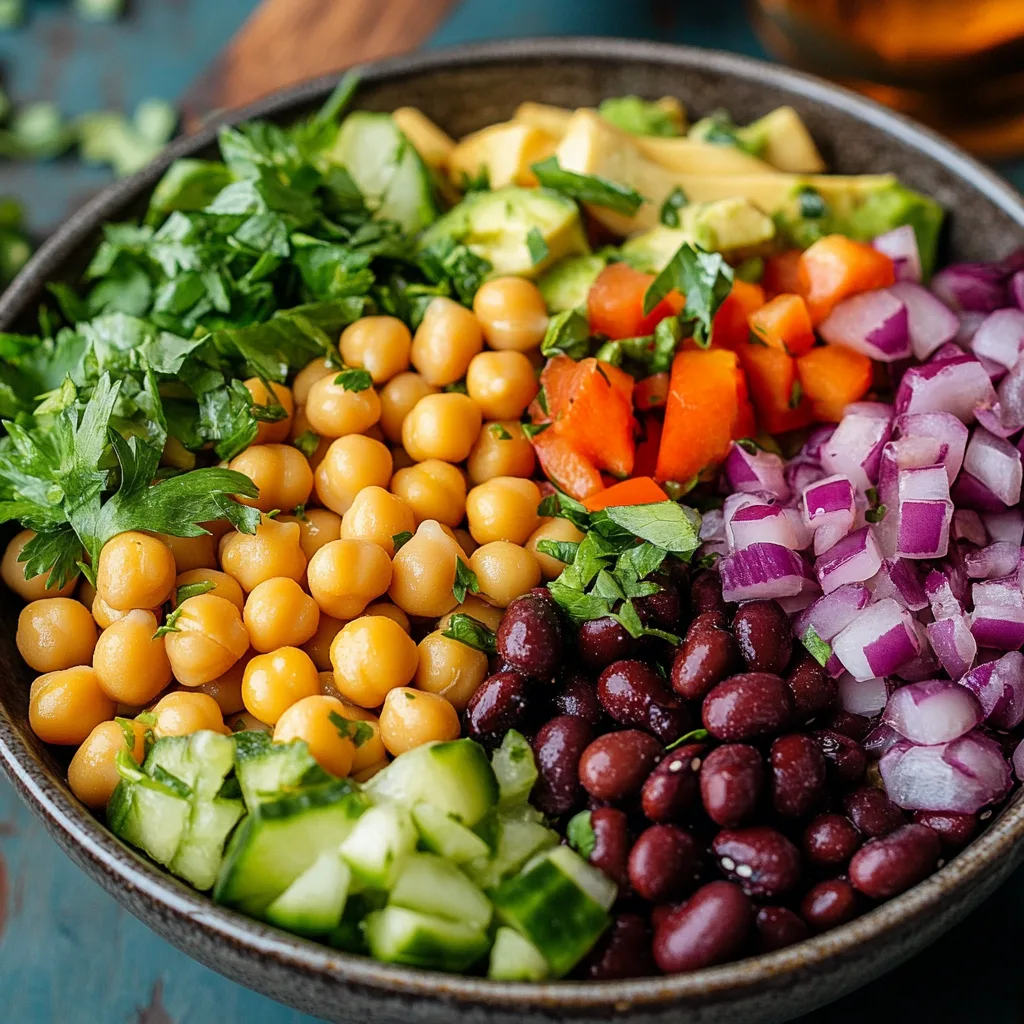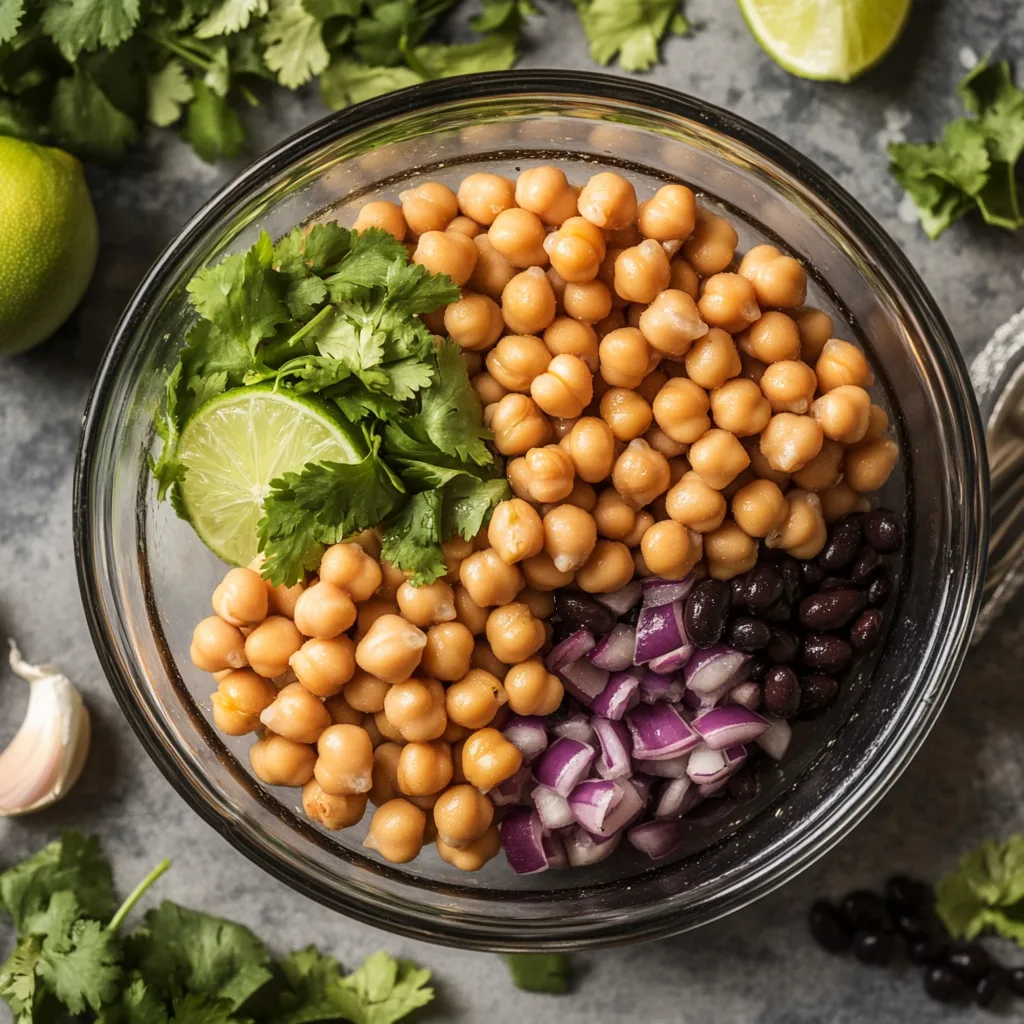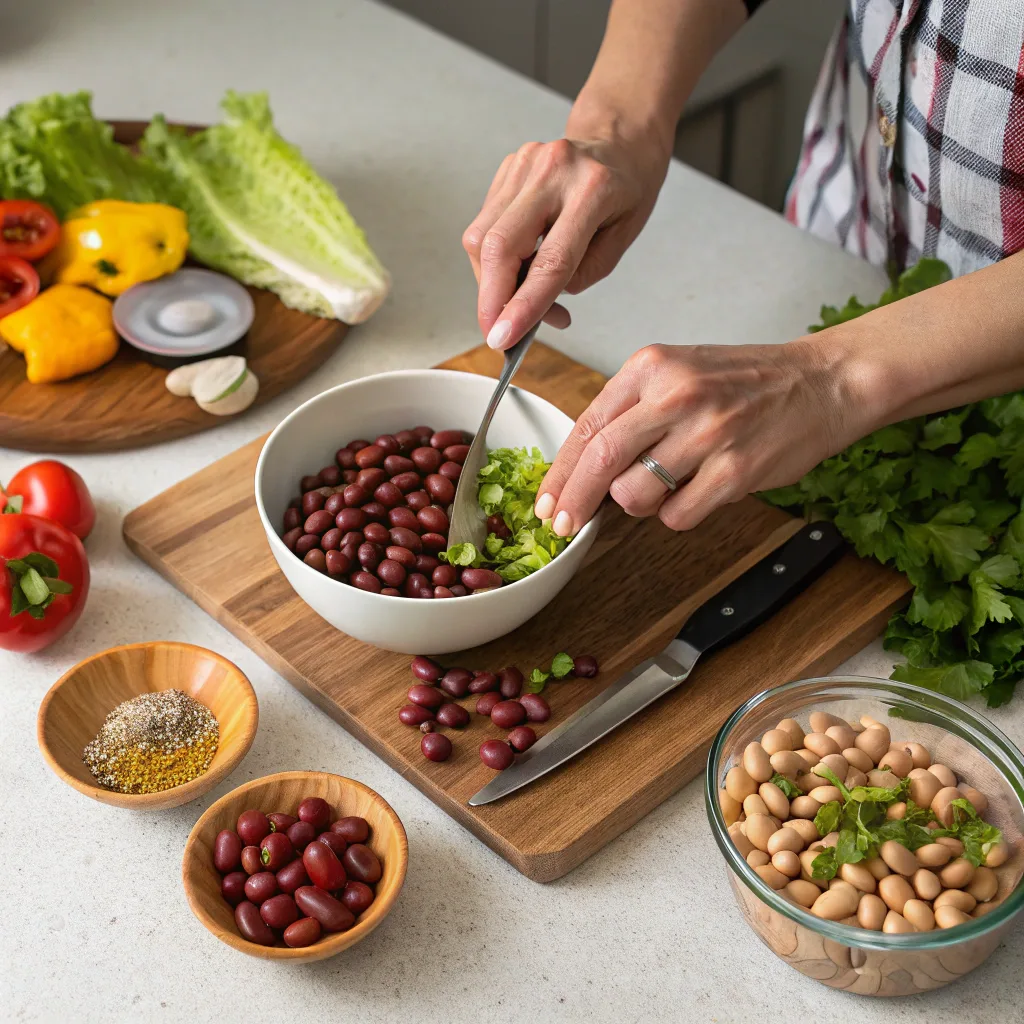Introduction
When it comes to creating a nutritionally packed and flavorful salad, beans are an unsung hero. They are a powerhouse of nutrients, adding protein, fiber, and essential vitamins to any dish. Plus, they’re incredibly versatile—pairing effortlessly with a variety of vegetables, grains, and dressings. This article dives into what is the healthiest beans to put in a salad and analyze how you can heighten your salad game while staying health-conscious. From top bean options to tips for preparation and even tasty recipes, this guide has you covered.
Introduction to Healthy Beans for Salads
What makes beans a healthy choice for salads?
Beans aren’t just delicious; they’re nutritional rock stars. These humble legumes are brimming with plant-based protein and dietary fiber, making them a perfect addition to any salad. Protein helps with muscle repair and keeps you full, while fiber supports a healthy digestive system. Beans also have a low glycemic index, so they release energy slowly, keeping you fueled throughout the day.
What’s more, beans are packed with antioxidants, vitamins like folate, and minerals such as iron and magnesium. For those on a plant-based diet, they’re a fantastic alternative to meat, offering a complete nutritional profile when paired with grains. Tossing beans into a salad not only adds texture but also transforms your dish into a satisfying and nutrient-rich meal.
Nutritional benefits of beans in a salad diet
Adding beans to your salads is a surefire way to boost your overall nutrient intake. For starters, they’re an excellent source of complex carbohydrates, which provide steady energy. Black beans and kidney beans, for instance, are rich in anthocyanins—antioxidants that combat free radicals and reduce inflammation.
Beans also support heart health due to their high potassium and low sodium content. Potassium helps regulate blood pressure, while their soluble fiber can lower bad cholesterol levels. If you’re watching your weight, beans are low in fat yet filling, which can help control portion sizes. Plus, they’re naturally gluten-free, making them suitable for a variety of dietary needs.
By adding beans to your salad, you’re not just boosting nutrition; you’re creating a balanced, flavorful dish that satisfies hunger and supports your health goals. Let’s dive deeper into the best bean options for salads in the next section!
Top Healthy Beans for Salads
Black Beans: High in Antioxidants
Black beans, with their mild sweetness and creamy texture, are a popular choice for salads. They’re loaded with antioxidants, particularly anthocyanins, which are known to fight oxidative stress and promote cell health. These small yet mighty beans also pack a punch of protein and fiber, which help keep you full for longer. When tossed with fresh greens, tomatoes, and a lime-based dressing, black beans create a satisfying salad that’s both delicious and healthy.
Additionally, black beans are rich in magnesium, an essential mineral for muscle and nerve function. They are particularly beneficial for people looking to stabilize blood sugar levels. So, if you’re wondering, what is the healthiest beans to put in a salad?, black beans deserve a spot on your plate.
Chickpeas: A Protein-Packed Choice
Chickpeas, or garbanzo beans, are another standout option for salads. Their nutty taste and firm texture make them a versatile ingredient that complements nearly any combination of vegetables. Packed with plant-based protein and dietary fiber, chickpeas help maintain steady energy levels throughout the day.
Moreover, chickpeas are a fantastic source of folate and iron, both of which are crucial for red blood cell production and preventing anemia. They’re especially popular in Mediterranean salads, where they’re paired with ingredients like cucumbers, olives, and feta cheese. Whether roasted, boiled, or canned, chickpeas are a go-to choice for a hearty and nutritious salad.
Kidney Beans: Loaded with Iron and Folate
Kidney beans are not only visually striking but also nutritionally dense. These vibrant red beans are a fantastic source of iron and folate, making them ideal for boosting energy and supporting overall health. Their firm texture adds a satisfying bite to any salad, especially when paired with crunchy greens and tangy vinaigrettes.
Kidney beans are also high in soluble fiber, which helps lower LDL cholesterol and promote heart health. If you’re looking for a simple yet nourishing way to add to your salad, kidney beans are an excellent choice.
Edamame: Rich in Plant-Based Protein
Edamame, or young soybeans, are a protein powerhouse. These beans contain all nine essential amino acids, making them a complete protein source. Edamame is also rich in antioxidants like isoflavones, which may support bone health and reduce inflammation. Toss them into a salad with red cabbage and sesame seeds for a vibrant and protein-rich dish.
Lentils: A Fiber-Rich Addition
Lentils are a top pick for anyone aiming to increase fiber intake. These tiny legumes are packed with dietary fiber, which aids digestion and helps maintain steady blood sugar levels. Lentils are also rich in folate, iron, and polyphenols, which are plant compounds with antioxidant properties.
In salads, lentils work well with roasted vegetables and light dressings. Their earthy flavor adds depth, while their nutrient profile makes your salad even more wholesome.
How to Choose the Right Beans for Your Salad
Understanding the Nutritional Needs of Your Diet
Selecting the right beans for your salad depends on your dietary goals. For instance, if you’re seeking a high-protein option, edamame or chickpeas are excellent choices. On the other hand, if you want to increase fiber, black beans or lentils might be the way to go. Beans like kidney beans are particularly helpful for those needing more iron in their diet.
When deciding what is the healthiest beans to put in a salad, it’s essential to consider how they fit into your overall nutrition plan. Balancing protein, fiber, and essential minerals assure that your salad not only tastes great but also meets your dietary needs.
Balancing Flavor, Texture, and Health Benefits
Beans are incredibly versatile, which makes them perfect for experimenting with flavors and textures. For a creamy texture, opt for chickpeas; for a firmer bite, kidney beans are ideal. Combining different types of beans, such as black beans and edamame, can create a nutrient-dense salad that’s also visually appealing.
Don’t forget to pair your beans with complementary ingredients. For instance, tangy dressings like balsamic or citrus-based vinaigrettes can add to the natural flavors of beans, while adding fresh herbs like parsley or cilantro boosts both taste and nutrition.
Preparing Beans for Salads
Should You Use Canned or Dried Beans?
When choosing beans for salads, many wonder, what is the healthiest beans to put in a salad? While canned beans are quick and convenient, dried beans often have superior flavor and texture. Canned beans save time, but they can come with high sodium levels, so it’s essential to rinse them thoroughly. This step not only reduces salt but also removes the starchy residue.
On the other hand, dried beans are a more natural option. By soaking and cooking dried beans, you can control their texture and avoid preservatives. For the freshest and healthiest addition to your salad, dried beans are often the better choice.
Tips for Cooking and Seasoning Beans for Salads
To make beans shine in your salads, proper preparation is key. If you’ve chosen dried beans, soak them overnight to reduce cooking time and improve digestion. As they cook, adding bay leaves or garlic infuses them with flavor without overpowering their natural taste. Wondering what is the healthiest beans to put in a salad? Black beans and lentils are excellent choices, offering both nutritional value and great taste.
After cooking, toss the beans with olive oil, lemon juice, and a pinch of salt to add to their flavor. Light seasoning assure the beans blend perfectly with other salad ingredients while keeping the dish fresh and healthy.
For inspiration, check out this Dense Bean Salad Recipe, which demonstrates how to create a balanced and hearty salad using beans.
Salad Recipes Featuring Healthy Beans
Mediterranean Chickpea Salad
If you’re searching for what is the healthiest beans to put in a salad, chickpeas are an easy winner. This recipe combines protein-packed chickpeas with cucumbers, tomatoes, red onions, and parsley. A simple lemon-olive oil dressing ties the ingredients together, while a sprinkle of feta cheese adds a creamy texture. This Mediterranean-inspired salad is both nutritious and bursting with flavor.
Southwestern Black Bean Salad
Black beans are another top answer to the question, what is the healthiest beans to put in a salad? They’re rich in fiber and antioxidants, making them a healthy and versatile option. Combine black beans with corn, red peppers, and avocado, then toss everything with a lime-cilantro vinaigrette. This bold salad is not only colorful but also incredibly filling, thanks to the combination of beans and healthy fats. Harvard T.H. Chan School of Public Health: Beans and Legumes
Lentil and Arugula Salad
Lentils are among the best beans for salads due to their high fiber and earthy flavor. This recipe pairs lentils with arugula, cherry tomatoes, and goat cheese, creating a perfect balance of textures and tastes. If you’re still wondering, what is the healthiest beans to put in a salad? Lentils are an excellent option for their nutritional punch and versatility.
Edamame and Quinoa Salad
Edamame, or young soybeans, offer complete protein and a satisfying crunch. In this recipe, they’re combined with quinoa, shredded cabbage, and sesame seeds. Tossed with a sesame-ginger dressing, this salad answers the question, what is the healthiest beans to put in a salad?, especially for those seeking a protein-rich and antioxidant-packed option.
Salad Recipes Featuring Healthy Beans
Mediterranean Chickpea Salad
This classic recipe combines protein-rich chickpeas with fresh cucumbers, tomatoes, red onions, and a sprinkle of parsley. Drizzle it with a simple dressing made from olive oil, lemon juice, and garlic. The result is a refreshing, nutritious salad that’s perfect for any occasion.
Southwestern Black Bean Salad
For a salad with a kick, mix black beans with sweet corn, red bell peppers, and creamy avocado. A zesty lime-cilantro dressing ties the ingredients together beautifully. Not only is this salad colorful, but it’s also rich in antioxidants and fiber.
Lentil and Arugula Salad
Earthy lentils pair wonderfully with peppery arugula in this flavorful recipe. Add cherry tomatoes, thinly sliced red onions, and a sprinkle of goat cheese. A balsamic glaze or vinaigrette adds just the right amount of tang, making this salad a well-rounded dish.
Edamame and Quinoa Salad
Packed with plant-based protein, this vibrant salad features edamame, cooked quinoa, shredded red cabbage, and sesame seeds. Toss it with a light sesame-ginger dressing for a crunch-filled and nutrient-rich salad that’s both satisfying and healthy.
Frequently Asked Questions
What are the healthiest beans for weight loss?
When it comes to weight loss, beans like black beans and lentils are top contenders. They are low in calories but packed with fiber and protein, which help you feel full longer and reduce unnecessary snacking. Additionally, these beans have a low glycemic index, meaning they help maintain stable blood sugar levels. Including them in salads not only supports weight management but also adds a boost of nutrients. If you’re still wondering, what is the healthiest beans to put in a salad?, black beans and lentils are excellent options for keeping your meals light and healthy.
Can I mix multiple types of beans in one salad?
Absolutely! Mixing different types of beans not only add to the nutritional value but also makes your salad more colorful and flavorful. For instance, combining kidney beans, chickpeas, and edamame can provide a balance of protein, fiber, and antioxidants. This mix also introduces various textures, making each bite more enjoyable. Just be sure to pair them with a dressing that complements all the flavors.
What are some common allergens to consider with beans?
Some beans, like edamame (soybeans), can trigger allergies in certain individuals. Additionally, canned beans may contain preservatives or added ingredients that could cause reactions. Always check labels for hidden allergens, and if you’re unsure, consult with a healthcare professional. For those with sensitive digestion, soaking dried beans before cooking can help reduce bloating and discomfort.
Common Mistakes to Avoid When Adding Beans to Salads
Using Too Many Types of Beans
While mixing beans can add variety, using too many different types can overwhelm your salad. Each bean has its own texture and flavor, and adding more than three or four kinds might create a dish that feels chaotic rather than balanced. To avoid this, choose beans that complement each other. For example, pairing black beans and kidney beans works well because their flavors are mild and their textures are similar.
Not Rinsing Canned Beans Properly
Canned beans are convenient, but they’re often packed in salty or starchy liquids. Failing to rinse them thoroughly can result in a salad that tastes overly salty or muddy. Always drain and rinse canned beans under cold water until the liquid runs clear. This small step assure your salad remains fresh and light, enhancing the beans’ natural flavors.
Overcooking Beans
For those who prefer cooking dried beans, overcooking is a common mistake. Mushy beans can fall apart and ruin the salad’s texture. To prevent this, cook beans until they’re tender but still hold their shape. After cooking, cool them quickly to stop further softening.
Ignoring Flavor Pairings
Beans are versatile, but they taste better when paired thoughtfully. Avoid combining beans with overly sweet or heavy dressings that might overpower their subtle flavors. Instead, opt for citrus-based or vinaigrette dressings that bring out their nutty, earthy qualities.
Final Thoughts and Quick Tips for Bean-Based Salads
Why Beans Deserve a Place in Your Salads
Beans are an affordable, accessible, and nutrient-packed ingredient that transforms any salad into a wholesome meal. Their high protein and fiber content make them an excellent addition for anyone looking to stay full and animate throughout the day. If you’re asking, what is the healthiest beans to put in a salad?, options like black beans, chickpeas, and lentils are hard to beat for their nutritional value and versatility.
Quick Tips for Perfect Bean Salads
- Choose the Right Base: Start with greens like spinach, arugula, or kale that balance the hearty texture of beans.
- Season Wisely: add to the natural flavors of beans with olive oil, lemon juice, or a pinch of sea salt.
- Experiment with Toppings: Add crunch with seeds or nuts, and boost flavor with fresh herbs like parsley or cilantro.
- Make It Ahead: Bean salads often taste better the next day as the flavors meld together. Prepare them in advance for an easy, healthy meal.
By following these tips and avoiding common mistakes, you can create salads that are as nutritious as they are delicious. Whether you stick to classic chickpea recipes or experiment with lentils and edamame, beans are an invaluable ingredient for balanced eating.



